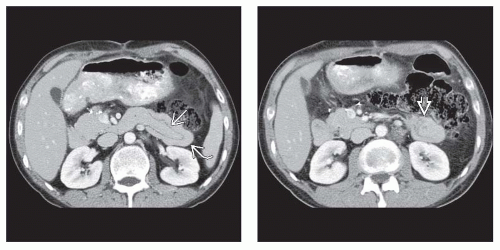Hamartomatous Polyposis (Peutz-Jeghers Syndrome)
Michael P. Federle, MD, FACR
R. Brooke Jeffrey, MD
Key Facts
Imaging
Best diagnostic clue
Cluster of small radiolucent filling defects in small bowel
Best imaging tool
Double-contrast barium studies (multiple views)
Top Differential Diagnoses
Familial adenomatous polyposis
Brunner gland hyperplasia (hamartoma)
Lymphoid follicles (hyperplasia)
Metastases and lymphoma (GI tract)
Pathology
Sessile/pedunculated; carpet-like, clustered, or scattered polyps
Clinical Issues
Most common signs/symptoms
Peutz-Jeghers syndrome: Pain, mucocutaneous pigmentation, melena
Lab data: Hypochromic anemia, positive stool guaiac test
Peutz-Jeghers syndrome complications
Intussusception, SBO, cancer risk
Prognosis: 40% risk of cancer by age 40
Treatment
Follow-up and surveillance
Surgery in malignant cases
Diagnostic Checklist
Imaging interpretation pearls
Peutz-Jeghers syndrome: Small bowel polyps, mucocutaneous pigmentation
Stay updated, free articles. Join our Telegram channel

Full access? Get Clinical Tree






